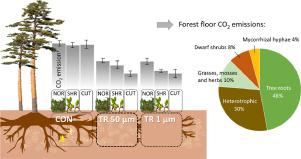当前位置:
X-MOL 学术
›
Agric. For. Meteorol.
›
论文详情
Our official English website, www.x-mol.net, welcomes your
feedback! (Note: you will need to create a separate account there.)
Partitioning of forest floor CO2 emissions reveals the belowground interactions between different plant groups in a Scots pine stand in southern Finland
Agricultural and Forest Meteorology ( IF 5.6 ) Pub Date : 2021-02-01 , DOI: 10.1016/j.agrformet.2020.108266 Kira Ryhti , Liisa Kulmala , Jukka Pumpanen , Jarkko Isotalo , Mari Pihlatie , Heljä-Sisko Helmisaari , Jaana Leppälammi-Kujansuu , Antti-Jussi Kieloaho , Jaana Bäck , Jussi Heinonsalo
Agricultural and Forest Meteorology ( IF 5.6 ) Pub Date : 2021-02-01 , DOI: 10.1016/j.agrformet.2020.108266 Kira Ryhti , Liisa Kulmala , Jukka Pumpanen , Jarkko Isotalo , Mari Pihlatie , Heljä-Sisko Helmisaari , Jaana Leppälammi-Kujansuu , Antti-Jussi Kieloaho , Jaana Bäck , Jussi Heinonsalo

|
Abstract Changes in the climate may have unpredictable effects on belowground carbon processes and thus, the carbon balance of boreal forests. To understand the interactions of these processes in soil and to quantify the potential changes in the carbon cycle, partitioning of forest floor respiration is crucial. For this purpose, we used nine different treatments to separate the sources of forest floor carbon dioxide (CO2) emissions in a mature Scots pine (Pinus sylvestris L.) stand in southern Finland. To partition the belowground CO2 emissions, we used two different trenching methods: 1) to exclude roots and mycorrhizal fungal mycelia (mesh with 1-µm pores) and 2) to exclude roots, but not mycorrhizal hyphae (mesh with 50-µm pores). Additionally, we used 3) a control treatment that included roots and fungal hyphae. To partition the CO2 emissions from the forest floor vegetation, we 1) removed it, 2) left only the dwarf shrubs, or 3) left the vegetation intact. The forest floor CO2 emissions were regularly measured with a flux chamber throughout the growing seasons in 2013–2015. The total forest floor respiration was partitioned into respiration of tree roots (contributing 48%), heterotrophic soil respiration (30%) and respiration of ground vegetation other than shrubs (10%), dwarf shrubs (8%), and hyphae of mycorrhizal fungi (4%). Heterotrophic respiration increased in the trenched treatments without ground vegetation over time, due to the so-called ‘Gadgil effect’. In the absence of tree roots, but when hyphal access was allowed, respiration in the dwarf shrub treatment increased throughout the experiment. This indicated that dwarf shrubs had fungal connections to outside the experimental plots via their ericoid mycorrhiza. At the same time, other ground vegetation, such as mosses, suppressed the dwarf shrub respiration in trenched treatments. Our results show that competition on the forest floor is intense between plant roots and soil microbes.
中文翻译:

森林地面二氧化碳排放的划分揭示了芬兰南部苏格兰松林不同植物群之间的地下相互作用
摘要 气候变化可能对地下碳过程产生不可预测的影响,从而对北方森林的碳平衡产生不可预测的影响。为了了解这些过程在土壤中的相互作用并量化碳循环中的潜在变化,森林地面呼吸的划分至关重要。为此,我们使用了九种不同的处理方法来分离芬兰南部成熟苏格兰松 (Pinus sylvestris L.) 林分中森林地面二氧化碳 (CO2) 排放的来源。为了划分地下 CO2 排放,我们使用了两种不同的挖沟方法:1) 排除根和菌根真菌菌丝体(具有 1-μm 孔的网格)和 2)排除根,但不排除菌根菌丝(具有 50-μm 孔的网格) . 此外,我们使用了 3) 包括根和真菌菌丝的对照处理。为了划分来自森林地面植被的 CO2 排放,我们 1) 将其移除,2) 只留下矮灌木,或 3) 保持植被完好无损。在 2013-2015 年的整个生长季节使用通量室定期测量森林地表 CO2 排放量。总森林地面呼吸分为树根呼吸(占48%)、异养土壤呼吸(30%)和除灌木以外的地面植被呼吸(10%)、矮灌木(8%)和菌根真菌菌丝呼吸(4%)。由于所谓的“Gadgil 效应”,随着时间的推移,在没有地面植被的沟渠处理中异养呼吸增加。在没有树根的情况下,但当允许菌丝进入时,矮灌木处理中的呼吸在整个实验过程中都会增加。这表明矮灌木通过它们的仙人掌菌根与实验地块外有真菌连接。与此同时,其他地面植被,如苔藓,在沟渠处理中抑制了矮灌木的呼吸。我们的结果表明,植物根系和土壤微生物之间在森林地面上的竞争非常激烈。
更新日期:2021-02-01
中文翻译:

森林地面二氧化碳排放的划分揭示了芬兰南部苏格兰松林不同植物群之间的地下相互作用
摘要 气候变化可能对地下碳过程产生不可预测的影响,从而对北方森林的碳平衡产生不可预测的影响。为了了解这些过程在土壤中的相互作用并量化碳循环中的潜在变化,森林地面呼吸的划分至关重要。为此,我们使用了九种不同的处理方法来分离芬兰南部成熟苏格兰松 (Pinus sylvestris L.) 林分中森林地面二氧化碳 (CO2) 排放的来源。为了划分地下 CO2 排放,我们使用了两种不同的挖沟方法:1) 排除根和菌根真菌菌丝体(具有 1-μm 孔的网格)和 2)排除根,但不排除菌根菌丝(具有 50-μm 孔的网格) . 此外,我们使用了 3) 包括根和真菌菌丝的对照处理。为了划分来自森林地面植被的 CO2 排放,我们 1) 将其移除,2) 只留下矮灌木,或 3) 保持植被完好无损。在 2013-2015 年的整个生长季节使用通量室定期测量森林地表 CO2 排放量。总森林地面呼吸分为树根呼吸(占48%)、异养土壤呼吸(30%)和除灌木以外的地面植被呼吸(10%)、矮灌木(8%)和菌根真菌菌丝呼吸(4%)。由于所谓的“Gadgil 效应”,随着时间的推移,在没有地面植被的沟渠处理中异养呼吸增加。在没有树根的情况下,但当允许菌丝进入时,矮灌木处理中的呼吸在整个实验过程中都会增加。这表明矮灌木通过它们的仙人掌菌根与实验地块外有真菌连接。与此同时,其他地面植被,如苔藓,在沟渠处理中抑制了矮灌木的呼吸。我们的结果表明,植物根系和土壤微生物之间在森林地面上的竞争非常激烈。











































 京公网安备 11010802027423号
京公网安备 11010802027423号